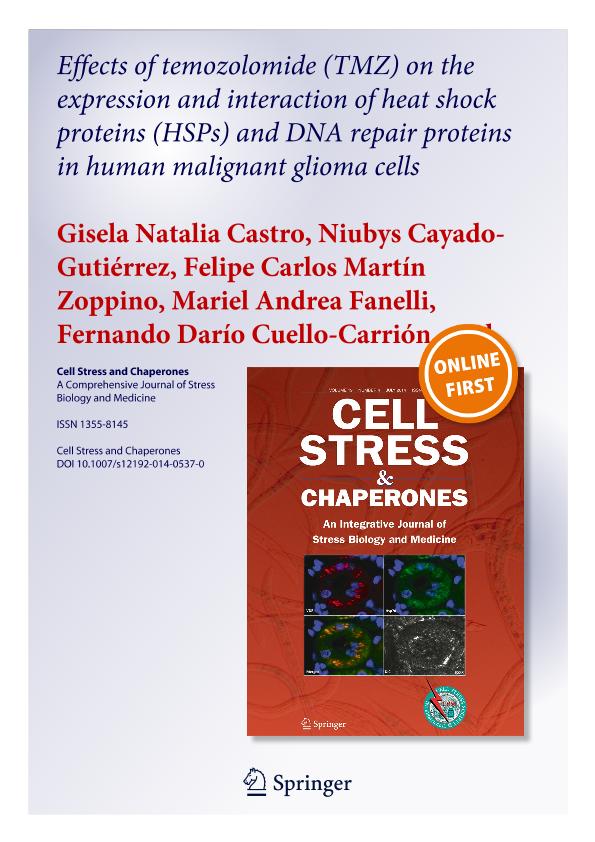Mostrar el registro sencillo del ítem
dc.contributor.author
Castro, Gisela Natalia

dc.contributor.author
Cayado Gutiérrez, Niubys de Los Milagros

dc.contributor.author
Zoppino, Felipe Carlos Martin

dc.contributor.author
Fanelli, Mariel Andrea

dc.contributor.author
Cuello Carrión, Fernando Darío

dc.contributor.author
Sottile Fleury, Mayra Lis

dc.contributor.author
Nadin, Silvina Beatriz

dc.contributor.author
Ciocca, Daniel Ramon

dc.date.available
2018-01-02T18:44:52Z
dc.date.issued
2014-08
dc.identifier.citation
Castro, Gisela Natalia; Cayado Gutiérrez, Niubys de Los Milagros; Zoppino, Felipe Carlos Martin; Fanelli, Mariel Andrea; Cuello Carrión, Fernando Darío; et al.; Effects of temozolomide (TMZ) on the expression and interaction of heat shock proteins (HSPs) and DNA repair proteins in human malignant glioma cells; Springer; Cell Stress & Chaperones; 20; 2; 8-2014; 253-265
dc.identifier.issn
1355-8145
dc.identifier.uri
http://hdl.handle.net/11336/32012
dc.description.abstract
We previously reported the association of HSPA1A and HSPB1 with high-grade astrocytomas, suggesting that these proteins might be involved in disease outcome and response to treatment. With the aim to better understand the resistance/susceptibility processes associated to temozolomide (TMZ) treatment, the current study was performed in three human malignant glioma cell lines by focusing on several levels: (a) apoptotic index and senescence, (b) DNA damage, and (c) interaction of HSPB1 with players of the DNA damage response. Three human glioma cell lines, Gli36, U87, and DBTRG, were treated with TMZ evaluating cell viability and survival, apoptosis, senescence, and comets (comet assay). The expression of HSPA (HSPA1A and HSPA8), HSPB1, O6-methylguanine-DNA methyltransferase (MGMT), MLH1, and MSH2 was determined by immunocytochemistry, immunofluorescence, and Western blot. Immunoprecipitation was used to analyze protein interaction. The cell lines exhibited differences in viability, apoptosis, and senescence after TMZ administration. We then focused on Gli36 cells (relatively unstudied) which showed very low recovery capacity following TMZ treatment, and this was related to high DNA damage levels; however, the cells maintained their viability. In these cells, MGMT, MSH2, HSPA, and HSPB1 levels increased significantly after TMZ administration. In addition, MSH2 and HSPB1 proteins appeared co-localized by confocal microscopy. This co-localization increased after TMZ treatment, and in immunoprecipitation analysis, MSH2 and HSPB1 appeared interacting. In contrast, HSPB1 did not interact with MGMT. We show in glioma cells the biological effects of TMZ and how this drug affects the expression levels of heat shock proteins (HSPs), MGMT, MSH2, and MLH1. In Gli36 cells, the results suggest that interactions between HSPB1 and MSH2, including co-nuclear localization, may be important in determining cell sensitivity to TMZ.
dc.format
application/pdf
dc.language.iso
eng
dc.publisher
Springer

dc.rights
info:eu-repo/semantics/openAccess
dc.rights.uri
https://creativecommons.org/licenses/by-nc-sa/2.5/ar/
dc.subject
Temozolomide
dc.subject
Glioma
dc.subject
Hspb1
dc.subject
Msh2
dc.subject
Mgmt
dc.subject.classification
Otras Ciencias de la Salud

dc.subject.classification
Ciencias de la Salud

dc.subject.classification
CIENCIAS MÉDICAS Y DE LA SALUD

dc.title
Effects of temozolomide (TMZ) on the expression and interaction of heat shock proteins (HSPs) and DNA repair proteins in human malignant glioma cells
dc.type
info:eu-repo/semantics/article
dc.type
info:ar-repo/semantics/artículo
dc.type
info:eu-repo/semantics/publishedVersion
dc.date.updated
2017-12-29T14:14:36Z
dc.identifier.eissn
1466-1268
dc.journal.volume
20
dc.journal.number
2
dc.journal.pagination
253-265
dc.journal.pais
Países Bajos

dc.journal.ciudad
Ámsterdam
dc.description.fil
Fil: Castro, Gisela Natalia. Consejo Nacional de Investigaciones Científicas y Técnicas. Centro Científico Tecnológico Conicet - Mendoza. Instituto de Medicina y Biología Experimental de Cuyo; Argentina
dc.description.fil
Fil: Cayado Gutiérrez, Niubys de Los Milagros. Consejo Nacional de Investigaciones Científicas y Técnicas. Centro Científico Tecnológico Conicet - Mendoza. Instituto de Medicina y Biología Experimental de Cuyo; Argentina
dc.description.fil
Fil: Zoppino, Felipe Carlos Martin. Consejo Nacional de Investigaciones Científicas y Técnicas. Centro Científico Tecnológico Conicet - Mendoza. Instituto de Medicina y Biología Experimental de Cuyo; Argentina
dc.description.fil
Fil: Fanelli, Mariel Andrea. Consejo Nacional de Investigaciones Científicas y Técnicas. Centro Científico Tecnológico Conicet - Mendoza. Instituto de Medicina y Biología Experimental de Cuyo; Argentina
dc.description.fil
Fil: Cuello Carrión, Fernando Darío. Consejo Nacional de Investigaciones Científicas y Técnicas. Centro Científico Tecnológico Conicet - Mendoza. Instituto de Medicina y Biología Experimental de Cuyo; Argentina
dc.description.fil
Fil: Sottile Fleury, Mayra Lis. Consejo Nacional de Investigaciones Científicas y Técnicas. Centro Científico Tecnológico Conicet - Mendoza. Instituto de Medicina y Biología Experimental de Cuyo; Argentina
dc.description.fil
Fil: Nadin, Silvina Beatriz. Consejo Nacional de Investigaciones Científicas y Técnicas. Centro Científico Tecnológico Conicet - Mendoza. Instituto de Medicina y Biología Experimental de Cuyo; Argentina
dc.description.fil
Fil: Ciocca, Daniel Ramon. Consejo Nacional de Investigaciones Científicas y Técnicas. Centro Científico Tecnológico Conicet - Mendoza. Instituto de Medicina y Biología Experimental de Cuyo; Argentina
dc.journal.title
Cell Stress & Chaperones

dc.relation.alternativeid
info:eu-repo/semantics/altIdentifier/doi/http://dx.doi.org/10.1007/s12192-014-0537-0
dc.relation.alternativeid
info:eu-repo/semantics/altIdentifier/url/https://link.springer.com/article/10.1007%2Fs12192-014-0537-0
Archivos asociados
